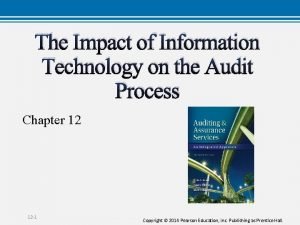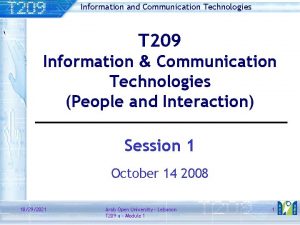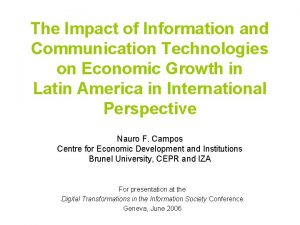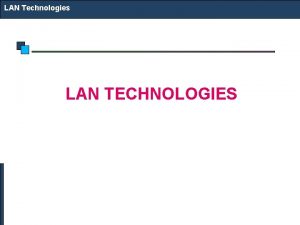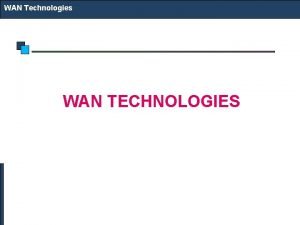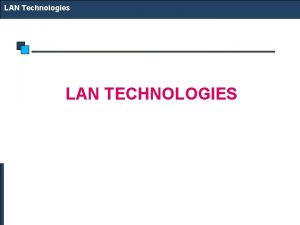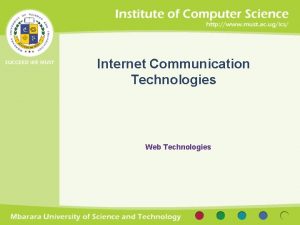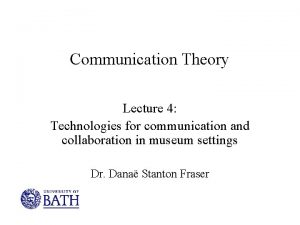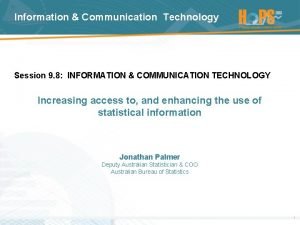The Impact of Information and Communication Technologies on











![Baseline results (cont) (1) Mobile penetration (2) (3) (4) (5) 0. 0209*** [0. 0034] Baseline results (cont) (1) Mobile penetration (2) (3) (4) (5) 0. 0209*** [0. 0034]](https://slidetodoc.com/presentation_image_h/99d90a3bb6c82161dab51ccb44dd6345/image-12.jpg)
![Baseline results (LAC only) Mobile penetration 0. 0137** [0. 0068] Fixed penetration 0. 362*** Baseline results (LAC only) Mobile penetration 0. 0137** [0. 0068] Fixed penetration 0. 362***](https://slidetodoc.com/presentation_image_h/99d90a3bb6c82161dab51ccb44dd6345/image-13.jpg)


![Endogenous growth model (cont) Mobile penetration 0. 00140*** [0. 00031] Fixed penetration 0. 00580*** Endogenous growth model (cont) Mobile penetration 0. 00140*** [0. 00031] Fixed penetration 0. 00580***](https://slidetodoc.com/presentation_image_h/99d90a3bb6c82161dab51ccb44dd6345/image-16.jpg)








- Slides: 24

The Impact of Information and Communication Technologies on Economic Growth in Latin America in International Perspective Nauro F. Campos Centre for Economic Development and Institutions Brunel University, CEPR and IZA For presentation at the Digital Transformations in the Information Society Conference Geneva, June 2006

Brief Project Overview • Part of a large research project trying to measure digital divide, focus on LAC • United Nations Economic Commission for Latin America (all opinions are mine) • Teams working on Growth Accounting Possible firm-level TICness indicators • Here: macro impact of TIC (LAC vs. World)

Research Questions • What is the impact of ICT on growth in LAC? • Is this impact smaller in LAC than in other regions of the world (OECD, Asia, Eastern Europe, Africa)? • Has the impact of ICT on Latin American growth changed since 1960?

Broadly Related Literature • Evidence from labour economics, e. g. Dolton and Makepeace (EJ 2004) • Evidence from firm-level studies, e. g. Brynjolfsson and Hitt (REStat 2003) • Evidence from growth accounting, e. g. Jorgenson (Handbook Econ Growth 2005) • Focus here is on TIC’s growth payoff using aggregate production function framework

Closely Related Literature 1963: Jipp, A. , “Wealth of Nations and Telephone Density, ” Telecomm Journal 1980: Hardy, A. , “The role of the telephone in economic development, ” Telecomm Policy 15 DCs + 45 LDCs, phones yes radios no, no effects on split samples 1991: Cronin et al. , “Telecommunications Infrastructure and Economic Growth: An Analysis of Causality, ’ Telecomm Policy Feedback system (annual data)

Closely Related Recent Literature 2001: Röller and Waverman (AER) Reverse causality, OECD countries 2004: Sridhar and Sridhar (WIDER conf) Extend RW; find impact smaller in LDCs 2004: Teltscher and Korka (Infodensity ITU) 147 countries; ICT elasticity btw. 1/. 3 2005: Waverman, Mescchi and Fuss (TPRC conf) Impact of ICT on growth larger in LDCs

Lessons from Recent Literature What are desirable next steps? • DATA: PANEL • PANEL ESTIMATION • ENDOGENEITY • POOLABILITY • ICT COMPOSITE and INSTITUTIONS

What have we done in this project? • DATA: PANEL: put together extensive panel data set: 170 countries, 1960 to 2005 (5 -year avgs), 42 ICT indicators • ESTIMATION: exploit panel aspect, std & endogenous growth model (Islam, QJE 1995) • ENDOGENEITY: exploratory Granger-causality • POOLABILITY: supports runs by individual regions

Poolability issues • 153 countries; 5 -year averages since 1960 (9 periods max); 1110 observations • Can we pool the data? • Is the model for OECD the same as for Africa? Are the coefficients the same? • The answer for our data is that you should NOT pool all data together… • … but you can pool by region! • OECD, LAC, MENA, Asia, Africa, TEs

Endogeneity concerns • 150 countries; 5 -year averages since 1960 • Fixed and mobile penetration • Granger-causality tests: coefficient [p-value] TIC to Growth? Growth to TIC? Fixed lines penetration Mobile lines penetration . 001 [0. 140] . 003 [. 001] 1. 01 [0. 540] -5. 37 [0. 462]

Baseline results (fixed-effects) Capital Population Leg. Effectiveness OECD Latin America Asia Transition Africa (1) (2) (3) (4) (5) 0. 132*** 0. 140*** -0. 0201 0. 165*** -0. 0254 [0. 043] [0. 039] [0. 042] [0. 039] -0. 197*** -0. 175*** -0. 485*** -0. 144*** -0. 114*** [0. 035] [0. 033] [0. 032] [0. 025] -0. 00215 -0. 00168 -0. 00044 -0. 00074 -0. 00031 [0. 0022] [0. 0021] [0. 0016] [0. 0017] [0. 0015] 1. 209*** 1. 165*** 0. 464** 1. 144*** 0. 422** [0. 22] [0. 20] [0. 19] [0. 20] [0. 18] -0. 067 -0. 061 -0. 112 -0. 0589 -0. 105 [0. 22] [0. 21] [0. 19] [0. 21] [0. 17] -0. 471* -0. 504** -0. 176 -0. 519** -0. 173 [0. 25] [0. 23] [0. 20] [0. 23] [0. 18] -0. 103 -0. 0879 -0. 312 -0. 0981 -0. 383** [0. 24] [0. 23] [0. 21] [0. 23] [0. 19] -1. 402*** -1. 349*** -0. 593*** -1. 323*** -0. 541*** [0. 22] [0. 21] [0. 19]
![Baseline results cont 1 Mobile penetration 2 3 4 5 0 0209 0 0034 Baseline results (cont) (1) Mobile penetration (2) (3) (4) (5) 0. 0209*** [0. 0034]](https://slidetodoc.com/presentation_image_h/99d90a3bb6c82161dab51ccb44dd6345/image-12.jpg)
Baseline results (cont) (1) Mobile penetration (2) (3) (4) (5) 0. 0209*** [0. 0034] Fixed penetration 0. 351*** [0. 023] Mobile per capita 0. 0923*** penetration [0. 010] Fixed per capita 0. 371*** penetration Constant Time dummies? Observations Number of countries R-squared [0. 022] 10. 67*** 10. 31*** 11. 71*** 9. 768*** 9. 779*** [0. 65] [0. 60] [0. 52] [0. 60] [0. 47] Yes Yes Yes 1110 1035 153 153 153 0. 6328 0. 6544 0. 7972 0. 6660 0. 8155
![Baseline results LAC only Mobile penetration 0 0137 0 0068 Fixed penetration 0 362 Baseline results (LAC only) Mobile penetration 0. 0137** [0. 0068] Fixed penetration 0. 362***](https://slidetodoc.com/presentation_image_h/99d90a3bb6c82161dab51ccb44dd6345/image-13.jpg)
Baseline results (LAC only) Mobile penetration 0. 0137** [0. 0068] Fixed penetration 0. 362*** [0. 051] Mobile pc penet 0. 101*** [0. 037] Fixed pc penet 0. 356*** [0. 050] Constant 9. 605*** 9. 486*** 10. 45*** 9. 292*** 8. 791*** [0. 85] [0. 77] [0. 66] [0. 79] [0. 62] Time dummies? Yes Yes Yes Observations 214 188 24 24 24 0. 0924 0. 1139 0. 6306 0. 1229 0. 6240 Number of countries R-squared

Summary of regression results Aggregate production model: OECD LAC Asia AFRICA MENA TEs only fixed and mobile only fixed and mobile (>LAC) (<LAC)

Endogenous growth model Initial income Capital Population Human capital Leg. Effectiveness OECD Latin America Asia Transition Africa (1) (2) (3) (4) (5) -0. 0114*** -0. 0133*** -0. 0185*** -0. 0115*** -0. 0186*** [0. 0022] [0. 0023] [0. 0033] [0. 0022] [0. 0033] 0. 0362*** 0. 0366*** 0. 0355*** 0. 0364*** 0. 0356*** [0. 0043] [0. 0042] [0. 0047] [0. 0043] [0. 0047] -0. 00069 -0. 0012 -0. 0061*** -0. 00064 -0. 0003 [0. 00087] [0. 00088] [0. 0021] [0. 00085] [0. 00088] 0. 00183 0. 00290* 0. 00129 0. 00216 0. 00128 [0. 0015] [0. 0018] 0. 000328** 0. 00035*** 0. 000340** 0. 000333** 0. 000339** [0. 00014] [0. 00015] 0. 0275*** 0. 0259*** 0. 0242*** 0. 0269*** 0. 0243*** [0. 0072] [0. 0069] [0. 0070] [0. 0069] 0. 00356 0. 00251 0. 00196 0. 00327 0. 00196 [0. 0065] [0. 0064] 0. 0174*** 0. 0152** 0. 0176*** 0. 0170*** 0. 0176*** [0. 0063] [0. 0061] 0. 0229** 0. 0199** 0. 0218** 0. 0220** 0. 0219** [0. 0097] [0. 0093] [0. 0094] -0. 00662 -0. 00742 -0. 00312 -0. 0065 -0. 00319 [0. 0068] [0. 0067] [0. 0069] [0. 0066] [0. 0069]
![Endogenous growth model cont Mobile penetration 0 00140 0 00031 Fixed penetration 0 00580 Endogenous growth model (cont) Mobile penetration 0. 00140*** [0. 00031] Fixed penetration 0. 00580***](https://slidetodoc.com/presentation_image_h/99d90a3bb6c82161dab51ccb44dd6345/image-16.jpg)
Endogenous growth model (cont) Mobile penetration 0. 00140*** [0. 00031] Fixed penetration 0. 00580*** [0. 0018] Mobile pc penet 0. 000552** [0. 00089] Fixed pc penet 0. 00582*** [0. 0018] Constant 0. 0124 0. 0328 0. 0924** 0. 0112 0. 0657* [0. 025] [0. 026] [0. 041] [0. 025] [0. 035] Time dummies? Yes Yes Yes Observations 829 780 Number of countries 105 105 105 0. 3626 0. 3816 0. 3927 0. 3647 0. 3925 R-squared

Summary of regression results Endogenous growth model: OECD LAC Asia AFRICA MENA weak for mobile only fixed (>LAC) only mobile

Conclusions • ICT have large impact on growth even in the poorest countries • Impact seems robust: different regions • Impact seems robust: reverse causality

Extensions • Institutions? Adequate investment climate, regulatory framework and economic reforms seem necessary to growth and will be incorporated • An aggregate indicator of TICness

ICT Indicators • Standard measures: fixed phone lines and mobile phone lines penetration • A composite indicator capturing the multi -faceted nature of ICT is desirable • An index of TICness?

TICness Index • 140 countries; 3 points in time: 1990 -1994, 19951999 and 2000 -2004 • Goal-post method, equal weights • Six underlying variables: – – – mobile penetration (per capita) import of telecom equip (%GDP) outgoing international calls (per capita) Internet hosts (per capita) price of internet connection high-technology exports (%GDP)


Thank you

Existing ICT Indicators Ar. Co DAI DOI EIU IKS KEI NRI Index Name Technolog y Capabilitie s for Countries Digital Access Index Digital Opportunity Index e-readiness ranking Index of Knowledge Societies Knowledge Economy Index Publisher Archibugi & Coco ITU Economist Intelligence Unit (EIU) UN Department of Econ &Social Affairs Pub date 2003 Dec-03 2005 April 2005 Countries 162 178 40 Variables 8 8 Subjective variables No # publications Data year Historical comparisons Orbicom TAI UNCTAD UNPAN WBICT Network Readiness Index Infostate Technology Achievemen t Index of ICT Diffusion EGovernment Readiness Index ICT Index World Bank Institute World Economic Forum Orbicom UNDP UNCTAD UN Division PAN World Bank 2005 March 2005 2003 2001 2005 Nov. 2004 2005 65 45 128 104 139 72 165 191 144 11 ~100 14 80 51 19 8 11 8 15 No No Yes** No Yes* No No Yes** No 1 1 1 6 1 NA 4 2 1 2 3 1 2000 2002 2003 No mention 2001 1995 -2000 2002 2000 -2002 2004 Rankings for 1995, 1999 -2002 Previous year; methodolog y changed between 1 and 2 publication No 1990, 2000 1998 & 2002 for 40 countries No Previous year; index has been changed No 1995, latest data Previous year; index has changed Scores provided for 1996 -2001 No
 Information systems and communication technologies quiz
Information systems and communication technologies quiz ©
© Current trends in media and information quiz
Current trends in media and information quiz Lyceum of information technologies
Lyceum of information technologies Tashkent university of information technology
Tashkent university of information technology Incvision
Incvision Impact of information technology on auditing
Impact of information technology on auditing Hình ảnh bộ gõ cơ thể búng tay
Hình ảnh bộ gõ cơ thể búng tay Slidetodoc
Slidetodoc Bổ thể
Bổ thể Tỉ lệ cơ thể trẻ em
Tỉ lệ cơ thể trẻ em Gấu đi như thế nào
Gấu đi như thế nào Tư thế worm breton
Tư thế worm breton Chúa yêu trần thế alleluia
Chúa yêu trần thế alleluia Các môn thể thao bắt đầu bằng tiếng bóng
Các môn thể thao bắt đầu bằng tiếng bóng Thế nào là hệ số cao nhất
Thế nào là hệ số cao nhất Các châu lục và đại dương trên thế giới
Các châu lục và đại dương trên thế giới Công thức tính thế năng
Công thức tính thế năng Trời xanh đây là của chúng ta thể thơ
Trời xanh đây là của chúng ta thể thơ Mật thư anh em như thể tay chân
Mật thư anh em như thể tay chân Phép trừ bù
Phép trừ bù độ dài liên kết
độ dài liên kết Các châu lục và đại dương trên thế giới
Các châu lục và đại dương trên thế giới Thể thơ truyền thống
Thể thơ truyền thống Quá trình desamine hóa có thể tạo ra
Quá trình desamine hóa có thể tạo ra






